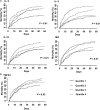Plasma inflammatory and apoptosis markers are associated with dialysis dependence and death among critically ill patients receiving renal replacement therapy
- PMID: 24619058
- PMCID: PMC4173817
- DOI: 10.1093/ndt/gfu051
Plasma inflammatory and apoptosis markers are associated with dialysis dependence and death among critically ill patients receiving renal replacement therapy
Abstract
Background: Survivors of critical illness complicated by acute kidney injury requiring renal replacement therapy (RRT) are at an increased risk of dialysis dependence and death but the mechanisms are unknown.
Methods: In a multicenter, prospective, cohort study of 817 critically ill patients receiving RRT, we examined association between Day 1 plasma inflammatory [interleukin (IL)-1β, IL-6, IL-8, IL-10 and IL-18; macrophage migration inhibitory factor (MIF) and tumor necrosis factor]; apoptosis [tumor necrosis factor receptor (TNFR)-I and TNFR-II and death receptor (DR)-5]; and growth factor (granulocyte macrophage colony stimulating factor) biomarkers and renal recovery and mortality at Day 60. Renal recovery was defined as alive and RRT independent.
Results: Of 817 participants, 36.5% were RRT independent and 50.8% died. After adjusting for differences in demographics, comorbid conditions; premorbid creatinine; nephrotoxins; sepsis; oliguria; mechanical ventilation; RRT dosing; and severity of illness, increased concentrations of plasma IL-8 and IL-18 and TNFR-I were independently associated with slower renal recovery [adjusted hazard ratio (AHR) range for all markers, 0.70-0.87]. Higher concentrations of IL-6, IL-8, IL-10 and IL-18; MIF; TNFR-I and DR-5 were associated with mortality (AHR range, 1.16-1.47). In an analysis of multiple markers simultaneously, increased IL-8 [AHR, 0.80, 95% confidence interval (95% CI) 0.70-0.91, P < 0.001] and TNFR-I (AHR, 0.63, 95% CI 0.50-0.79, P < 0.001) were associated with slower recovery, and increased IL-8 (AHR, 1.26, 95% CI 1.14-1.39, P < 0.001); MIF (AHR, 1.18, 95% CI 1.08-1.28, P < 0.001) and TNFR-I (AHR, 1.26, 95% CI 1.02-1.56, P < 0.03) were associated with mortality.
Conclusions: Elevated plasma concentrations of inflammatory and apoptosis biomarkers are associated with RRT dependence and death. Our data suggest that future interventions should investigate broad-spectrum immune-modulation to improve outcomes.
Keywords: acute kidney injury; biomarkers; mortality; renal recovery; renal replacement therapy.
© The Author 2014. Published by Oxford University Press on behalf of ERA-EDTA. All rights reserved.
Figures




Comment in
-
Stigmata of death: for kidneys and patients.Nephrol Dial Transplant. 2014 Oct;29(10):1797-8. doi: 10.1093/ndt/gfu103. Epub 2014 May 2. Nephrol Dial Transplant. 2014. PMID: 24792373 Free PMC article. No abstract available.
References
-
- Palevsky PM, Zhang JH, O'Connor TZ, et al. Intensity of renal support in critically ill patients with acute kidney injury. N Engl J Med. 2008;359:7–20. doi:10.1056/NEJMoa0802639. - DOI - PMC - PubMed
-
- Bellomo R, Cass A, Cole L, et al. Intensity of continuous renal-replacement therapy in critically ill patients. N Engl J Med. 2009;361:1627–1638. doi:10.1056/NEJMoa0902413. - DOI - PubMed
-
- Hamel MB, Phillips RS, Davis RB, et al. Outcomes and cost-effectiveness of initiating dialysis and continuing aggressive care in seriously ill hospitalized adults. SUPPORT Investigators. Study to Understand Prognoses and Preferences for Outcomes and Risks of Treatments. Ann Intern Med. 1997;127:195–202. doi:10.7326/0003-4819-127-3-199708010-00003. - DOI - PubMed
-
- Palevsky PM, O'Connor TZ, Chertow GM, et al. Intensity of renal replacement therapy in acute kidney injury: perspective from within the Acute Renal Failure Trial Network Study. Crit Care. 2009;13:310. doi:10.1186/cc7901. - DOI - PMC - PubMed
-
- Ng KP, Chanouzas D, Fallouh B, et al. Short and long-term outcome of patients with severe acute kidney injury requiring renal replacement therapy. QJM. 2012;105:33–39. doi:10.1093/qjmed/hcr133. - DOI - PubMed
Publication types
MeSH terms
Substances
Grants and funding
LinkOut - more resources
Full Text Sources
Other Literature Sources
Medical
Molecular Biology Databases
Miscellaneous

